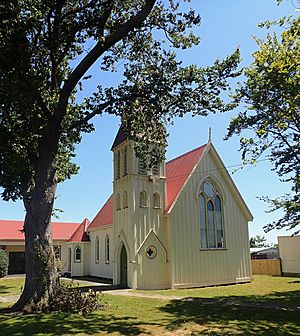Sanson, New Zealand facts for kids
Quick facts for kids
Sanson
|
|
|---|---|
|
Town
|
|

St Thomas' Anglican Church, built in 1877
|
|
| Country | New Zealand |
| Region | Manawatū-Whanganui |
| District | Manawatū District |
| Ward |
|
| Named for | Henry Sanson |
| Electorates |
|
| Area | |
| • Total | 0.60 km2 (0.23 sq mi) |
| Population
(June 2023)
|
|
| • Total | 670 |
| • Density | 1,117/km2 (2,890/sq mi) |
| Postcode |
4817
|
Sanson is a small town in the Manawatū District of New Zealand. It is located just south of Bulls and the Rangitīkei River. The city of Palmerston North is to its west.
Sanson is an important meeting point for two main roads in New Zealand. These are State Highway 1 and State Highway 3. For many years, from 1885 to 1945, a special tramway called the Sanson Tramway connected the town to the national train network. This tramway ran south to meet another train line in Himatangi.
History of Sanson
European people started settling in the Sanson area in the late 1860s. The land, known as the Sandon Block, was set aside for a town, not for farming. This was because soldiers were not allowed to buy town land back then.
The first settlers came from the Hutt Valley. The town was named after Henry Sanson, who was a secretary for a farming group there.
In the 1870s, Sanson was a small settlement with a few houses, a church, and other buildings along one main road. A photograph from that time shows the church next to a two-story house. There was a picket fence and a horse tied to a gate.
The Sanson tramway was a key part of the town's history. It ran from 1883 to 1945, connecting Sanson to the main railway line at Hīmatangi. An old photo from the early 1900s shows the tram line. On one side, there were wooden buildings. On the other, there was an unpaved street, a two-story store, and a local hotel.
By 2006, Sanson had become a popular stop for travelers on the highway. It had several shops selling crafts and antiques.
People of Sanson
Sanson is a rural settlement. It covers about 0.60 square kilometers. In 2018, the estimated population of Sanson was 582 people. This means there were about 970 people living in each square kilometer.
The population of Sanson has been growing:
- In 2006, there were 492 people.
- In 2013, there were 537 people.
- In 2018, there were 582 people.
This shows an increase of 45 people (8.4%) from 2013 to 2018. There were 237 households in 2018. There were more males (309) than females (276). About 120 people (20.6%) were under 15 years old.
Most people in Sanson (84.0%) are of European/Pākehā background. About 26.3% are Māori, and smaller numbers are Pacific peoples or Asian. Some people identify with more than one background.
When asked about religion, 58.2% of people said they had no religion. About 25.3% were Christian. A small number followed Māori religious beliefs or other religions.
Learning in Sanson
Sanson School is a primary school for students in Year 1 to 8. It teaches both boys and girls. The school moved to its current location in 1991. As of 2023, the school has about 115 students. It is located at the southern end of the town, just off State Highway 1.
At the front of the old Sanson School building, there is a special gate called the Sanson Memorial Gate. This gate was put up to remember soldiers who died in World War I. It was officially opened on August 31, 1924, and lists the names of twelve soldiers.
The closest high school for students in Year 9 to 13 is Feilding High School. It is about 17 kilometers away in the town of Feilding.
Blokarting in Sanson
Sanson is home to the Manawatū Blokart Club. Blokarting is a fun sport where you sail a small, three-wheeled kart on land.
In 2022, the club hosted two big events:
- The Blokarting 2022 New Zealand National Championships.
- The World Championships.
The World Championship event lasted five days. Two days of competition took place at the Sanson blokart track. The other three days were held on the airfield tarmac at the nearby RNZAF Base Ohakea.

